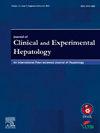Real-world Prevalence of Hepatitis B Reactivation in Patients With Resolved Hepatitis B Receiving Rituximab and Non-rituximab-based Immunosuppressive Therapy Without Chemoprophylaxis
IF 3.2
Q2 GASTROENTEROLOGY & HEPATOLOGY
Journal of Clinical and Experimental Hepatology
Pub Date : 2025-03-21
DOI:10.1016/j.jceh.2025.102551
引用次数: 0
Abstract
Background
Hepatitis B virus reactivation (HBVr) can occur in patients with resolved hepatitis B virus (HBV) infection receiving immunosuppressive therapy. The class of immunosuppression influences HBV reactivation (HBVr) risk, with B-cell depleting agents such as Rituximab conferring a higher risk. The presence of hepatitis B surface antibodies (HBsAb) may be protective against HBVr.
Objective
To compare the rates of HBVr amongst individuals with resolved HBV infection receiving rituximab and non-rituximab immunosuppressive therapy, without chemoprophylaxis. Our secondary objective was to explore the role of HBsAb in risk stratification for HBVr.
Methods
We retrospectively collected the data of patients with resolved HBV infection receiving immunosuppressants between 2014 and 2022. HBVr rates amongst patients receiving rituximab and non-rituximab therapy were compared. Logistic regression analysis was performed to identify risk factors for HBVr.
Results
148 patients with resolved HBV infection did not receive chemoprophylaxis. Of the 20 (13.5%) patients who developed HBVr, none developed HBV flare. 42 of the 148 (28.3%) patients received rituximab-based therapy. Patients who received rituximab had a higher risk of HBVr, 12(28.6%) vs 8(7.5%), P = 0.001. This was confirmed on multivariable analysis (OR 4.19 [C.I. 1.47–11.9], P = 0.007). HBsAb titres of above 100 mIU/ml were protective against HBVr (OR 0.04 [CI 0.001–0.84], P = 0.039) in the rituximab exposed cohort, but not in the non-rituximab exposed cohort.
Conclusion
The risk of HBVr was higher in patients receiving rituximab; however, no patient developed HBV flare. In patients with resolved HBV infection, the presence of HBsAb titres above 100 mIU/ml may confer additional protection against HBVr and can be used as part of risk stratification for HBVr. In such patients, close surveillance with on-demand therapy instead of chemoprophylaxis may be considered.

接受利妥昔单抗和非利妥昔单抗免疫抑制疗法但未进行化学预防的已治愈乙肝患者中乙肝再激活的实际发生率
背景接受免疫抑制治疗的乙型肝炎病毒(HBV)感染已治愈的患者可能会发生乙型肝炎病毒再激活(HBVr)。免疫抑制剂的种类会影响乙型肝炎病毒再激活(HBVr)的风险,利妥昔单抗等B细胞耗竭剂的风险更高。目的比较接受利妥昔单抗和非利妥昔单抗免疫抑制剂治疗且未进行化学预防的已治愈 HBV 感染者的 HBVr 发生率。我们的次要目标是探索 HBsAb 在 HBVr 风险分层中的作用。方法我们回顾性收集了 2014 年至 2022 年期间接受免疫抑制剂治疗的 HBV 感染缓解患者的数据。比较了接受利妥昔单抗治疗和非利妥昔单抗治疗患者的 HBVr 发生率。结果148名HBV感染缓解的患者未接受化学预防。在 20 例(13.5%)出现 HBVr 的患者中,没有人出现 HBV 复发。148 例患者中有 42 例(28.3%)接受了利妥昔单抗治疗。接受利妥昔单抗治疗的患者发生 HBVr 的风险较高,分别为 12 例(28.6%)与 8 例(7.5%),P = 0.001。多变量分析证实了这一点(OR 4.19 [C.I. 1.47-11.9],P = 0.007)。在利妥昔单抗暴露人群中,HBsAb滴度超过100 mIU/ml对HBVr有保护作用(OR 0.04 [CI 0.001-0.84],P = 0.039),但在非利妥昔单抗暴露人群中没有保护作用。在HBV感染缓解的患者中,HBsAb滴度超过100 mIU/ml可能会增加对HBVr的保护,可作为HBVr风险分层的一部分。对于这类患者,可以考虑通过按需治疗而不是化学预防进行密切监测。
本文章由计算机程序翻译,如有差异,请以英文原文为准。
求助全文
约1分钟内获得全文
求助全文
来源期刊

Journal of Clinical and Experimental Hepatology
GASTROENTEROLOGY & HEPATOLOGY-
CiteScore
4.90
自引率
16.70%
发文量
537
审稿时长
64 days
 求助内容:
求助内容: 应助结果提醒方式:
应助结果提醒方式:


